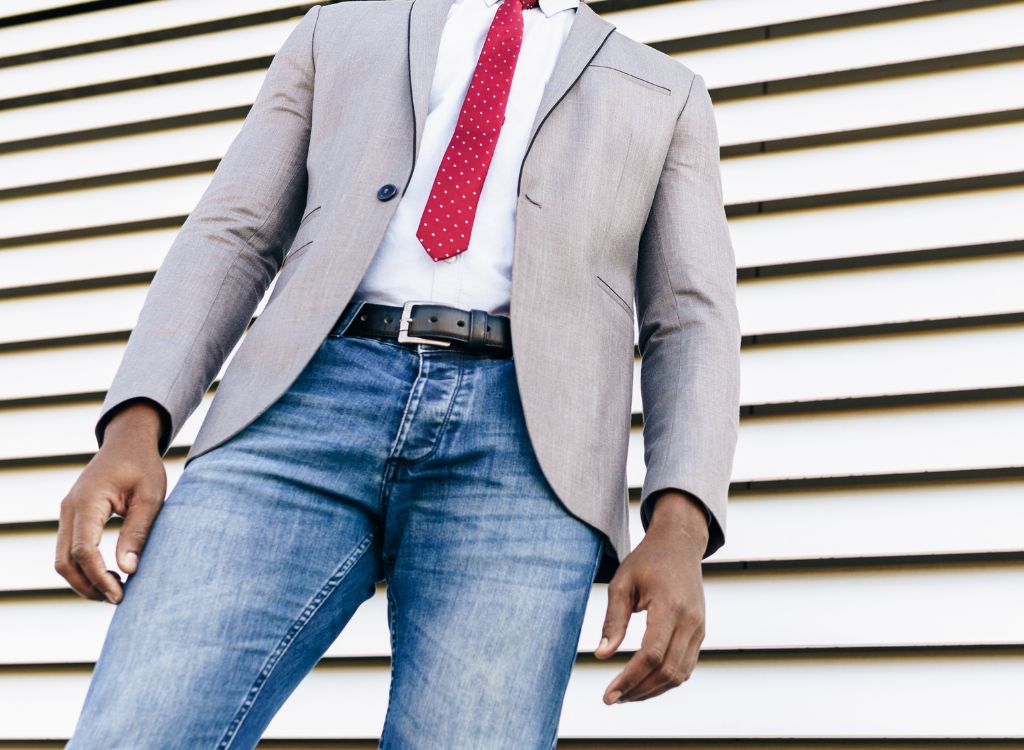The divide used to be clear: if you worked with your hands, in the field or in a factory, you could wear jeans to work. If you worked in an office, you couldn't.
That's no longer the case. More and more offices are allowing denim in the workplace.
Some even encourage it, as part of relaxed corporate culture that's deliberately designed to contrast more conservative models.
There's also a huge swath of the workforce employed in service-sector jobs that are neither manual labor nor white-collar office work: food service workers, retail employees, hoteliers, and more.
So, what are the rules on denim in the workplace?
When You Can't Wear Denim

It's easier to list the situations where jeans are an absolute deal-breaker than the ones where they're at least potentially acceptable, these days.
Here's the skinny on when you need to leave the denim at home:
- Anywhere ties are required. Ties and jeans are always a mis-match. (And yes, you'll see men doing it anyway. That doesn't mean it looks good.)
- Any time a uniform is required, such as a UPS driver's brown trousers or a hotel cleaner's company-issue black pants.
- Anywhere jeans are explicitly prohibited by company dress code (duh).
Outside of those situations, there's at least a chance that you can work jeans into your outfit. The key is in knowing which jeans to wear, and how to use them as part of your larger wardrobe.
The Jeans You Can (and Can't) Wear to Work

“Work jeans” originally meant just that — denim pants for hard physical labor. They were plain, tough pants that could take a beating, washed easily, and could be cheaply re-dyed in a sink or bathtub to refresh their look.
Those aren't the jeans most men should be wearing to work.
For “dress casual” clothing, jeans should be darker, tighter, and simpler than their working-class progenitors. Acceptable jeans for most kinds of non-manual-labor workplaces need to follow a slightly dressier rubric:
- Dark color (deep indigo is most common, but black and gray denim work as well — no light or bright blues!)
- Close fit in the crotch (no sagging)
- Some taper to the legs (no large boot-cut or flare at the ankles)
Some fashionable jeans feature “contrast stitching,” where the denim is dark but the stitching is done in white, yellow, or orange that stands out against the fabric.
While stylish, it's pushing the envelope for work wear — unless your office is very relaxed, save the contrast-stitched jeans for club wear, and keep it monochrome.
Here are some features that are automatic deal-breakers for denim in most office situations:
Any kind of “distressing” — rips, fringes, worn patches, etc. This should go without saying, really.
- Discoloration from bleaching or fading that makes the color patchy.
- Gear loops, cargo pockets, etc.
- Large logos or labels — a small label under the belt is fine, but anything oversized or printed on the legs is too showy.
Remember, jeans can be both expensive and stylish without being work-appropriate. The overall design needs to be subdued, not just from a high-end brand or store.
How to Wear Jeans in a Work Wardrobe
If you're going to wear jeans to an office, remember that you need to be dressing them up.
Jeans are still automatically casual. And that's fine, and can fit within the rubric of “dress casual” these days — but only if the rest of your outfit makes it clear that you're trying. Otherwise you just look lazy.
Jeans with Sports Jackets

A sportcoat is always going to be your best bet with blue jeans. It's a clear sign that “hey, yeah, I'm still dressing up here; I'm just keeping it comfortable and relaxed.”
Light, unstructured jackets work well with jeans. Corduroy is good, and so is cotton twill — though be careful of anything with a really visible diagonal weave that mimics the jeans too closely.
Your options for color and pattern are pretty broad.
So long as you steer clear of anything that mimics the jeans too closely, you should be in good shape. Wear a plain white shirt underneath for the most neutral base, or mix it up with some light colors and patterns for a more varied outfit.
Jeans with Blazers

The boxier, more structured cut of a blazer is a bit of a clash with the relaxed attitude of blue jeans.
You can do it, but understand that your options are going to be more limited than they are with a sports jacket.
Double-breasted is right out — the formality is too much of a clash with the jeans. And the traditional navy blue can also be problematic, as it's too close to matching a lot of deep indigo jeans.
The best way to do jeans and a blazer is to either have a lighter, non-blue color of jeans such as slate gray, or to wear a less traditional color of blazer.
Jeans with Suit Jackets

We've actually written about wearing suit jacket with jeans before, but to summarize that article very briefly: you can re-purpose a jacket from a matching suit and wear it with jeans instead if the jacket is a basic single-breasted model.
The fabric is conceivably something you could make a sports jacket out of (i.e., no charcoal gray superfine worsteds), and the jacket is in decent shape.
In most cases this ends up being a better evening look than a work look. Suit jackets tend to have a more tapered fit and a dressier look than sports jackets, and you get more of a stylistic contrast as a result.
Take it on a case-by-base basis, but in general don't plan on mixing and matching your suit jackets with your jeans for work wear.
Jeans with Dress Shirts and No Jacket
If you're really reluctant to wear a jacket, jeans can be worn with dress shirts.
The problem is that it doesn't have much of a deliberate attitude. You look like a guy who just grabbed a couple things out of his closet, threw them on, and went to work. Not the most impressive presentation in the world.
There are a couple of ways you can dress the look up a touch so that you're coming across as more deliberately-groomed:
- Wear good dress shirts. Get some with a little color and pattern, not just plain white, and make sure the fit is close (and that they stay tucked in — you don't want your shirttails popping out or ballooning into a muffin top).
- Get a stylish belt. An interesting color of letter or a decorative buckle goes a long way toward creating a “look.”
- Keep the shoes dressy. You should be wearing good leather, preferably something with some visual interest to it. Brogues, saddle shoes, wingtips, etc. will serve you better here than plain brown or black work shoes, or worse, sneakers.
Another good option for the fall and spring: throw a sweater on over the dress shirt. It's not a jacket, but it adds a little class and visual interest.
Not all offices are going to accept jeans and a shirt as sufficiently dressy. Be cautious trying this one unless you're sure it's allowed.
Jeans and a Polo Shirt
This is increasingly common at large chain retailers. You'll see it at places like Best Buy and Target.
Outside of those stores, it's too casual. If the owners are making you wear it that's one thing, but it's not a look you should voluntarily show up wearing on your own accord. People will think you haven't learned how to dress yourself like a grown-up yet.
Jeans and a Necktie
No. Just don't. Maybe for a funky social look; never for work. If you're wearing a necktie, put some slacks on. If you're wearing jeans, take the tie off.
The only people who wear jeans and a tie to work are car salesmen from the 1980s and franchise employees who don't get a choice. You're not those people; don't dress like them.
Wearing Jeans To Work: Conclusion
There is no clear-cut line on when jeans are and aren't appropriate at work anymore (unless, of course, you work somewhere with a dress code, and that dress code says “no jeans” or “jeans allowed”).
If you want to wear jeans to work, and you work inside in a non-manual-labor job, your best bet is to get a pair of dark, fitted jeans and try them with a dress shirt and a casual sports jacket.
If that's too dressy, then you can downgrade to just jeans and a dress shirt (but accent well, so that the outfit looks deliberate). And if jeans and a sports jacket is still too casual, you might want to give up on the idea of wearing jeans to work and get yourself some stylish slacks instead.
Good luck!
The post Wearing Denim To Work: Jeans For Business Casual appeared first on Real Men Real Style.
0 Commentaires